Dual-Band Resonant Acoustic Metasurfaces from Nested Negative Effective Parameter Unit
Abstract
1. Introduction
2. Model and Methods
2.1. Model
2.2. Theoretical Analysis
3. Results and Discussion
3.1. Resonant Metasurfaces Based on Single-Layer Structures
3.2. Resonant Metasurfaces Based on Tandem Nested Bilayers
3.3. Resonant Metasurfaces Based on Parallel Nested Double-Layer Structures
4. Conclusions
Author Contributions
Funding
Institutional Review Board Statement
Informed Consent Statement
Data Availability Statement
Conflicts of Interest
Abbreviations
| SHC | Split Hollow Cuboid |
| SHT | Single-Opening Hollow Tube |
| NSHC | Nested Split Hollow Cuboid |
| NSHT | Nested Single-Opening Hollow Tube |
| AMS | Acoustic Metasurface |
| PLA | Polylactic Acid |
References
- Iqbal, R.; Qureshi, U.U.R.; Jie, C.; Rahman, Z.U.; Jafar, N. Polarization and Incident Angle Independent Multifunctional and Multiband Tunable THz Metasurface Based on VO2. Nanomaterials 2024, 14, 1048. [Google Scholar] [CrossRef] [PubMed]
- Zhang, C.; Xue, T.; Zhang, J.; Liu, L.; Xie, J.; Wang, G.; Yao, J.; Zhu, W.; Ye, X. Terahertz toroidal metasurface biosensor for sensitive distinction of lung cancer cells. Nanophotonics 2021, 11, 101–109. [Google Scholar] [CrossRef] [PubMed]
- Liu, D.; Hao, L.; Zhu, W.; Yang, X.; Yan, X.; Guan, C.; Xie, Y.; Chen, Z. Recent Progress in Resonant Acoustic Metasurfaces. Materials 2023, 16, 7044. [Google Scholar] [CrossRef]
- Du, X.-Y.; Chen, A.L.; Wang, Y.-S. Acoustic antenna based on arbitrarily curved coding metasurface for three-dimensional beamforming. Mech. Syst. Signal Process. 2025, 232, 112710. [Google Scholar] [CrossRef]
- Guo, J.; Qu, R.; Fang, Y.; Yi, W.; Zhang, X. A phase-gradient acoustic metasurface for broadband duct noise attenuation in the presence of flow. Int. J. Mech. Sci. 2023, 237, 107822. [Google Scholar] [CrossRef]
- Zhou, H.T.; Fu, W.X.; Li, X.S.; Wang, Y.F.; Wang, Y.S. Loosely coupled reflective impedance metasurfaces: Precise manipulation of waterborne sound by topology optimization. Mech. Syst. Signal Process 2022, 177, 109228. [Google Scholar] [CrossRef]
- Li, H.Z.; Liu, X.C.; Liu, Q.; Li, S.; Yang, J.S.; Tong, L.L.; Shi, S.B.; Schmidt, R.; Schroeder, K.U. Sound insulation performance of double membrane-type acoustic metamaterials combined with a Helmholtz resonator. Appl. Acoust. 2023, 205, 109297. [Google Scholar] [CrossRef]
- Dong, H.W.; Shen, C.; Zhao, S.D.; Qiu, W.; Zheng, H.; Zhang, C.; Cummer, S.A.; Wang, Y.S.; Fang, D.; Cheng, L. Achromatic metasurfaces by dispersion customization for ultra-broadband acoustic beam engineering. Natl. Sci. Rev. 2022, 9, nwac030. [Google Scholar] [CrossRef]
- Hamidreza Taghvaee, F.L.; Daz-Rubio, A.; Tretyakov, S. Subwavelength focusing by engineered power-flow conformal metamirrors. Phys. Rev. B 2021, 104, 235409. [Google Scholar] [CrossRef]
- Zhu, Y.F.; Fan, X.D.; Liang, B.; Cheng, J.C.; Jing, Y. Ultrathin Acoustic Metasurface-Based Schroeder Diffuser. Phys. Rev. X 2017, 7, 021034. [Google Scholar] [CrossRef]
- Bi, S.; Yang, F.; Tang, S.; Shen, X.; Zhang, X.; Zhu, J.; Yang, X.; Peng, W.; Yuan, F. Effects of Aperture Shape on Absorption Property of Acoustic Metamaterial of Parallel-Connection Helmholtz Resonator. Materials 2023, 16, 1597. [Google Scholar] [CrossRef]
- Ijaz, S.; Noureen, S.; Rehman, B.; Zubair, M.; Massoud, Y.; Mehmood, M.Q. Multi-material described metasurface solar absorber design with absorption prediction using machine learning models. Mater. Today Commun. 2023, 36, 106377. [Google Scholar] [CrossRef]
- Cao, A.; Chen, N.; Zhu, W.; Chen, Z. Graphene-Based Dual-Band Metasurface Absorber with High Frequency Ratio. Nanomaterials 2024, 14, 1522. [Google Scholar] [CrossRef] [PubMed]
- Hao, L.; Chen, X.; Yan, X.; Li, Y.; Zhang, L.; Xie, Y.; Pang, S.; Chen, Z. Flexible Manipulation of the Reflected Wavefront Using Acoustic Metasurface with Split Hollow Cuboid. Materials 2022, 15, 1189. [Google Scholar] [CrossRef]
- Zhou, H.T.; Fan, S.W.; Li, X.S.; Fu, W.X.; Wang, Y.F.; Wang, Y.S. Tunable arc-shaped acoustic metasurface carpet cloak. Smart Mater. Struct. 2020, 29, 065016. [Google Scholar] [CrossRef]
- Zhu, Y.F.; Assouar, B. Multifunctional acoustic metasurface based on an array of Helmholtz resonators. Phys. Rev. B 2019, 99, 174109. [Google Scholar] [CrossRef]
- Ding, C.L.; Wang, Z.R.; Shen, F.L.; Chen, H.J.; Zhai, S.L.; Zhao, X.P. Experimental realization of acoustic metasurface with double-split hollow sphere. Solid State Commun. 2016, 229, 28–31. [Google Scholar] [CrossRef]
- Ding, C.L.; Chen, H.J.; Zhai, S.L.; Liu, S.; Zhao, X.P. The anomalous manipulation of acoustic waves based on planar metasurface with split hollow sphere. J. Phys. D Appl. Phys. 2015, 48, 045303. [Google Scholar] [CrossRef]
- Han, P.; Li, Z.; Zhang, Y.; Zhou, X.; Wang, D.; Zhang, K. Broadband tunable acoustic metasurface based on Helmholtz resonators. Acta Mech. Sin. 2025, 41, 124531. [Google Scholar] [CrossRef]
- Moore, D.B.; Smith, J.D.; Sambles, J.R.; Hibbins, A.P.; Starkey, T.A. Low-frequency acoustic surface waves on a coupled membrane-cavity metasurface. Phys. Rev. B 2025, 111, 155427. [Google Scholar] [CrossRef]
- Zhai, S.L.; Ding, C.L.; Chen, H.J.; Shen, F.L.; Luo, C.R.; Zhao, X.P. Anomalous Manipulation of Acoustic Wavefront With an Ultrathin Planar Metasurface. J. Vib. Acoust. Trans. ASME 2016, 138, 041019. [Google Scholar] [CrossRef]
- Jiang, R.; Shi, G.; Huang, C.; Zheng, W.; Li, S. Acoustic Insulation Characteristics and Optimal Design of Membrane-Type Metamaterials Loaded with Asymmetric Mass Blocks. Materials 2023, 16, 1308. [Google Scholar] [CrossRef]
- Li, J.; Shi, Y.; Jiang, R.; Zhang, Z.; Huang, Q. Acoustic Insulation Mechanism of Membrane-Type Acoustic Metamaterials Loaded with Arbitrarily Shaped Mass Blocks of Variable Surface Density. Materials 2022, 15, 1556. [Google Scholar] [CrossRef] [PubMed]
- Chen, X.; Liu, P.; Hou, Z.W.; Pei, Y.M. Implementation of acoustic demultiplexing with membrane-type metasurface in low frequency range. Appl. Phys. Lett. 2017, 110, 161909. [Google Scholar] [CrossRef]
- Chen, X.; Liu, P.; Hou, Z.; Pei, Y. Magnetic-control multifunctional acoustic metasurface for reflected wave manipulation at deep subwavelength scale. Sci. Rep. 2017, 7, 9050. [Google Scholar] [CrossRef]
- Zhang, J.Y.; Romero-Garcia, V.; Theocharis, G.; Richoux, O.; Achilleos, V.; Frantzeskakis, D.J. Second-Harmonic Generation in Membrane-Type Nonlinear Acoustic Metamaterials. Crystals 2016, 6, 86. [Google Scholar] [CrossRef]
- Chen, J.S.; Chen, Y.B.; Chen, H.W.; Yeh, Y.C. Bandwidth broadening for transmission loss of acoustic waves using coupled membrane-ring structure. Mater. Res. Express 2016, 3, 105801. [Google Scholar] [CrossRef]
- Li, Z.; Liu, J.; Zhang, J.; Shao, L.; Zhang, C.; Wang, X.; Jin, R.; Zhu, W. Shaping Electromagnetic Fields with Irregular Metasurface. Adv. Mater. Technol. 2022, 7, 2200035. [Google Scholar] [CrossRef]
- Bai, X.; Zhang, F.; Sun, L.; Cao, A.; He, C.; Zhang, J.; Zhu, W. Dynamic millimeter-wave OAM beam generation through programmable metasurface. Nanophotonics 2022, 11, 1389–1399. [Google Scholar] [CrossRef]
- Li, Z.; Zhang, D.; Liu, J.; Zhang, J.; Shao, L.; Wang, X.; Jin, R.; Zhu, W. 3-D Manipulation of Dual-Helical Electromagnetic Wavefronts With a Noninterleaved Metasurface. IEEE Trans. Antennas Propag. 2022, 70, 378–388. [Google Scholar] [CrossRef]
- Kamali, S.M.; Arbabi, E.; Arbabi, A.; Faraon, A. A review of dielectric optical metasurfaces for wavefront control. Nanophotonics 2018, 7, 1041–1068. [Google Scholar] [CrossRef]
- Erçağlar, V.; Hajian, H.; Serebryannikov, A.E.; Ozbay, E. Multifunctional tunable gradient metasurfaces for terahertz beam splitting and light absorption. Opt. Lett. 2021, 46, 3953–3956. [Google Scholar] [CrossRef]
- Weng, J.K.; Zhu, Y.F.; Liang, B.; Yang, J.; Cheng, J.C. Wavelength-dependent multi-functional wavefront manipulation for reflected acoustic waves. Appl. Phys. Express 2020, 13, 094003. [Google Scholar] [CrossRef]
- Chen, X.; Hao, L.; Yan, X.; Yang, X.; Liu, D.-A.; Zhang, X.; Pang, S.; Xie, Y.; Chen, Z. Multiband acoustic reflection metasurface with split hollow cubic. Mod. Phys. Lett. B 2023, 38, 2350220. [Google Scholar] [CrossRef]
- Ma, F.; Huang, M.; Xu, Y.; Wu, J.H. Bilayer synergetic coupling double negative acoustic metasurface and cloak. Sci. Rep. 2018, 8, 5906. [Google Scholar] [CrossRef]
- Wang, Y.B.; Luo, C.R.; Dong, B.; Zhai, S.L.; Ding, C.L.; Zhao, X.P. Ultrathin broadband acoustic reflection metasurface based on meta-molecule clusters. J. Phys. D Appl. Phys. 2019, 52, 085601. [Google Scholar] [CrossRef]
- Sridhar, A.; Liu, L.; Kouznetsova, V.G.; Geers, M.G.D. Homogenized enriched continuum analysis of acoustic metamaterials with negative stiffness and double negative effects. J. Mech. Phys. Solids 2018, 119, 104–117. [Google Scholar] [CrossRef]
- Rossing, T.D. The Science of Sound, 2nd ed.; Addison-Wesley Publishing Company: Don Mills, ON, Canada, 1990. [Google Scholar]
- Yang, X.; Hao, L.; Yan, X.; Liu, D.-A.; Guo, J.; Cheng, H.; Pang, S.; Xie, Y.; Chen, Z. Tunable double-layer dual-band metamaterial with negative mass density. Phys. Scr. 2023, 98, 115952. [Google Scholar] [CrossRef]
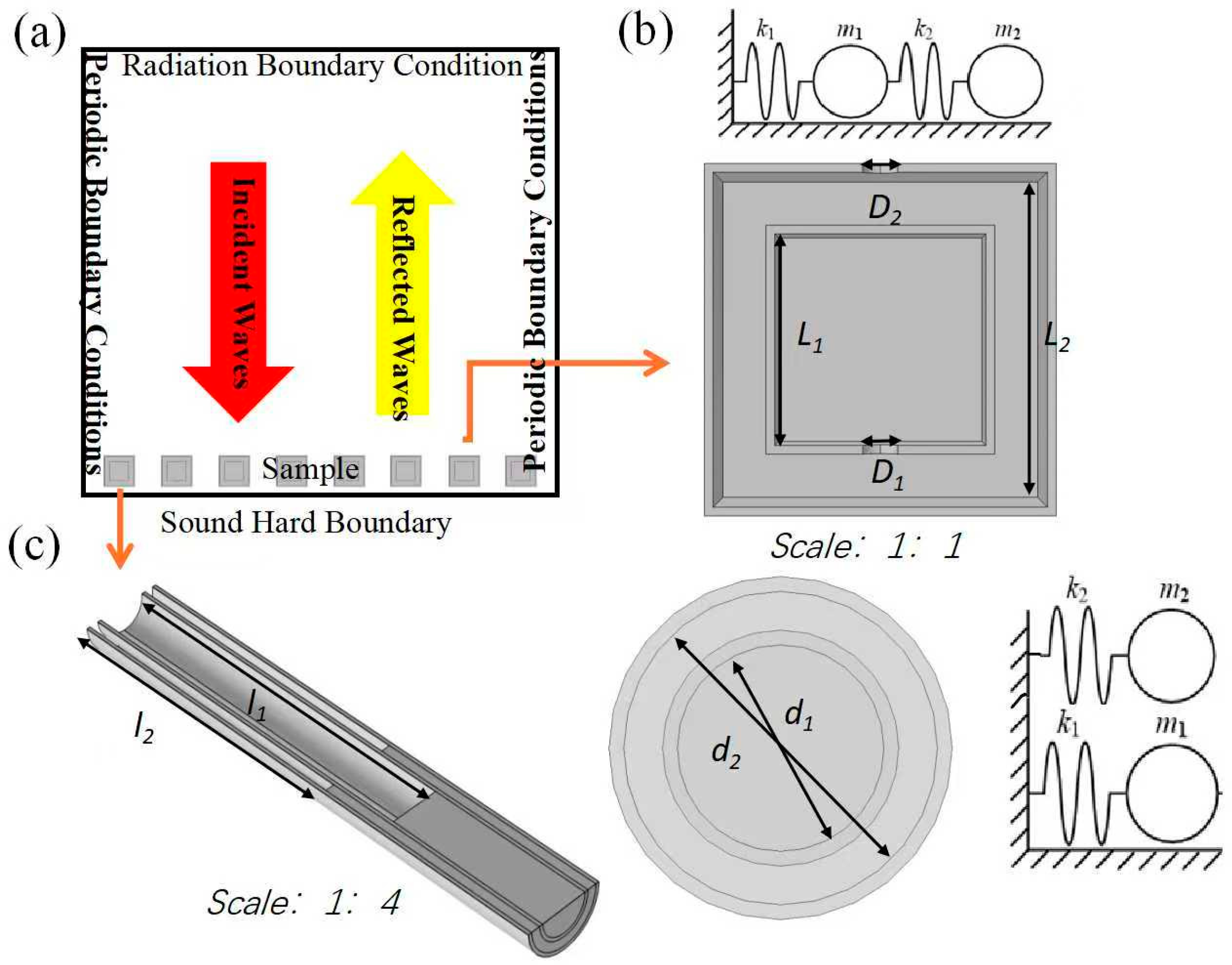


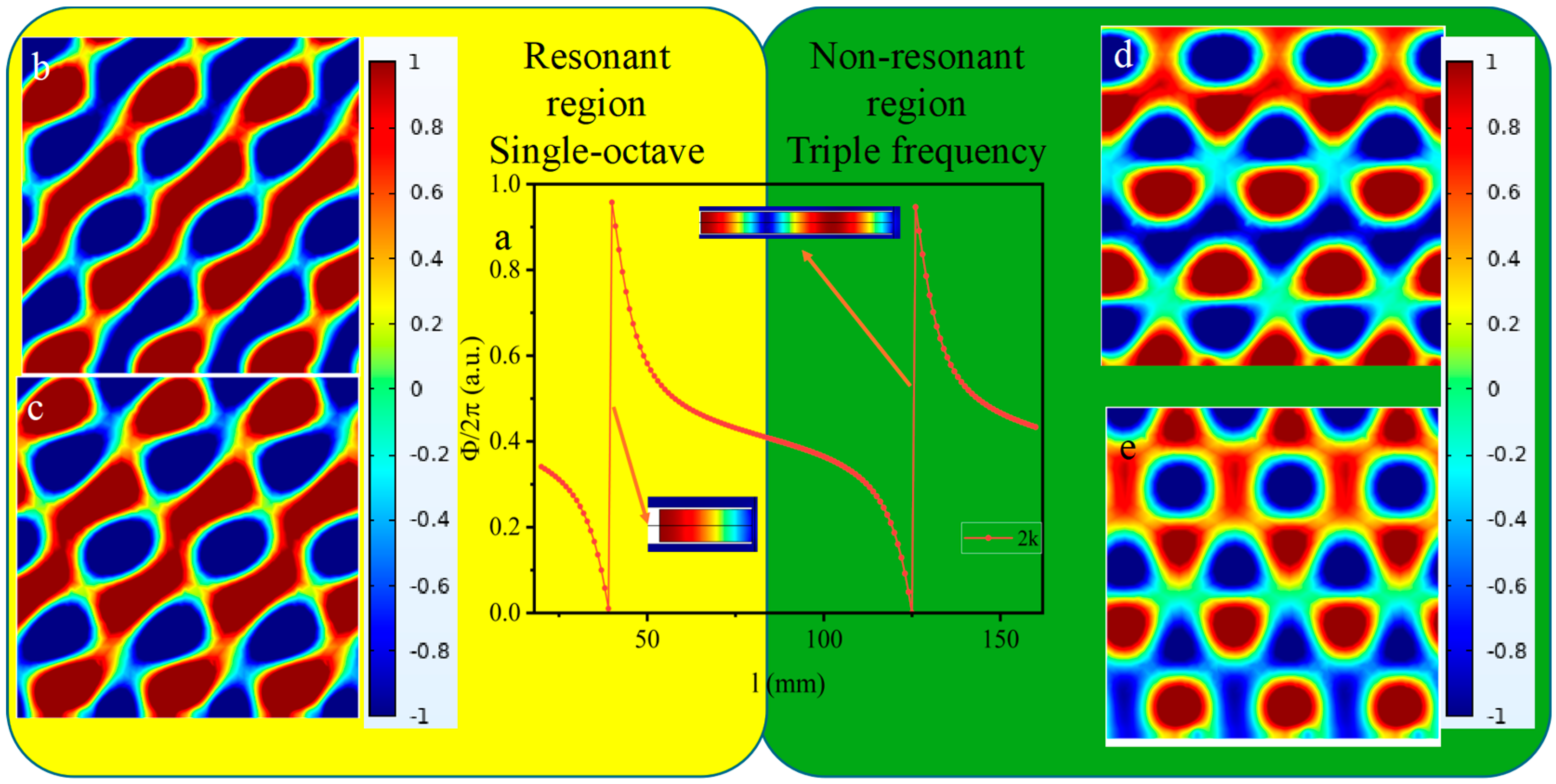
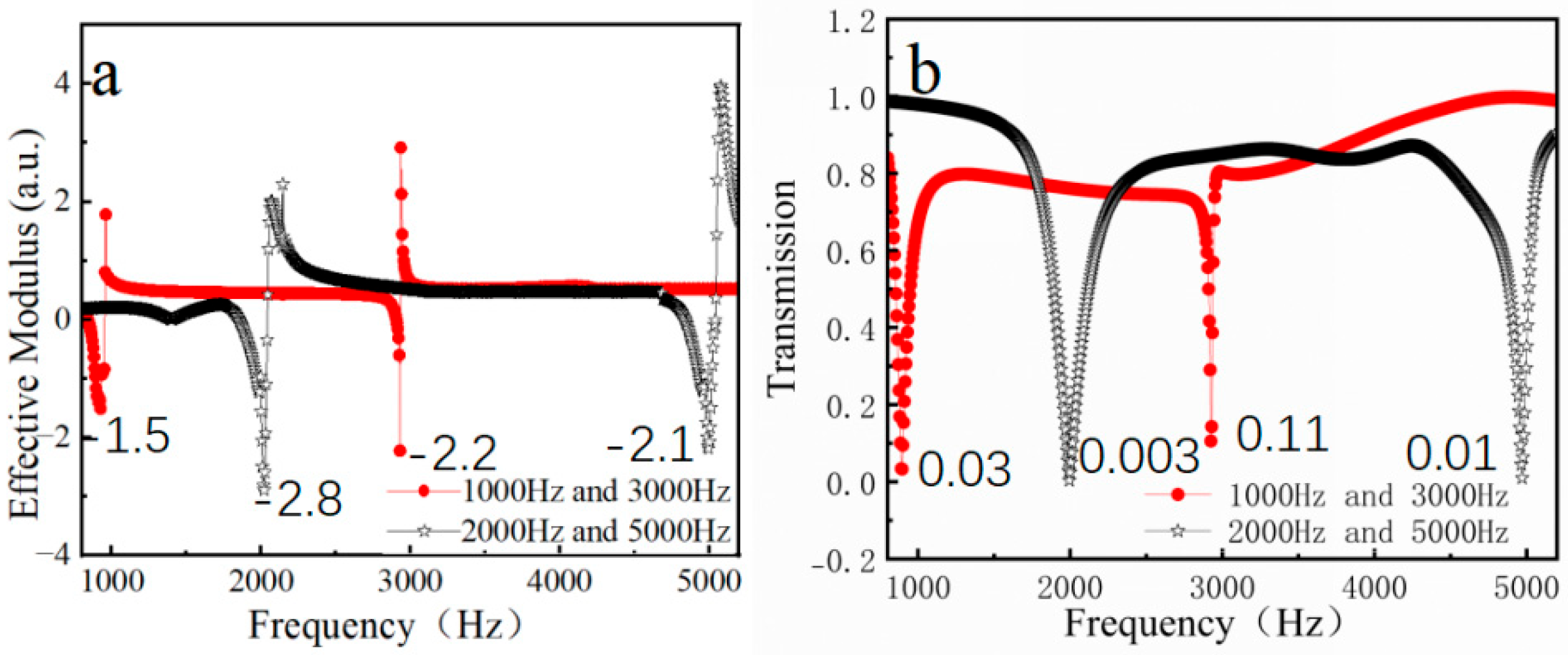
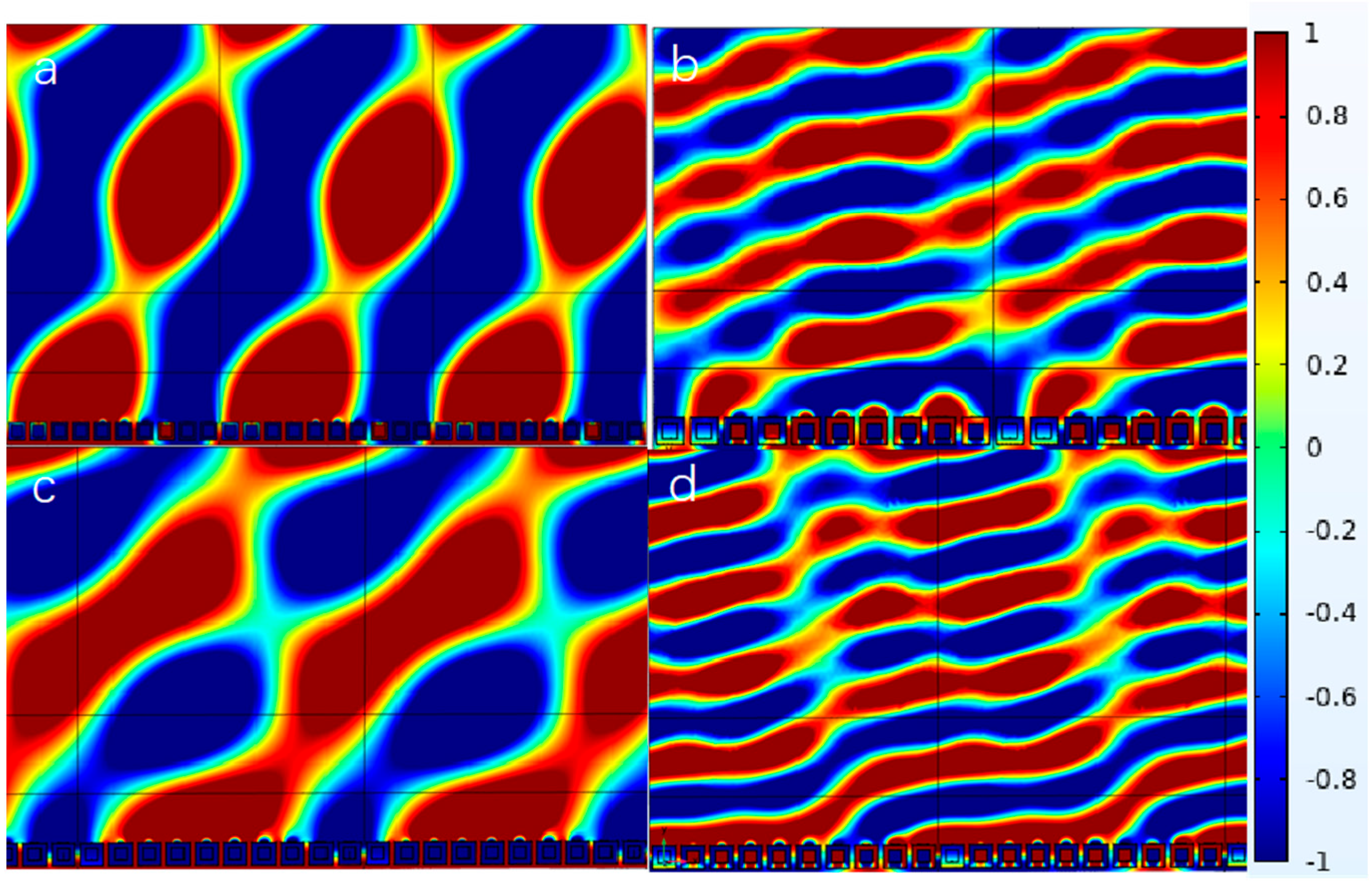
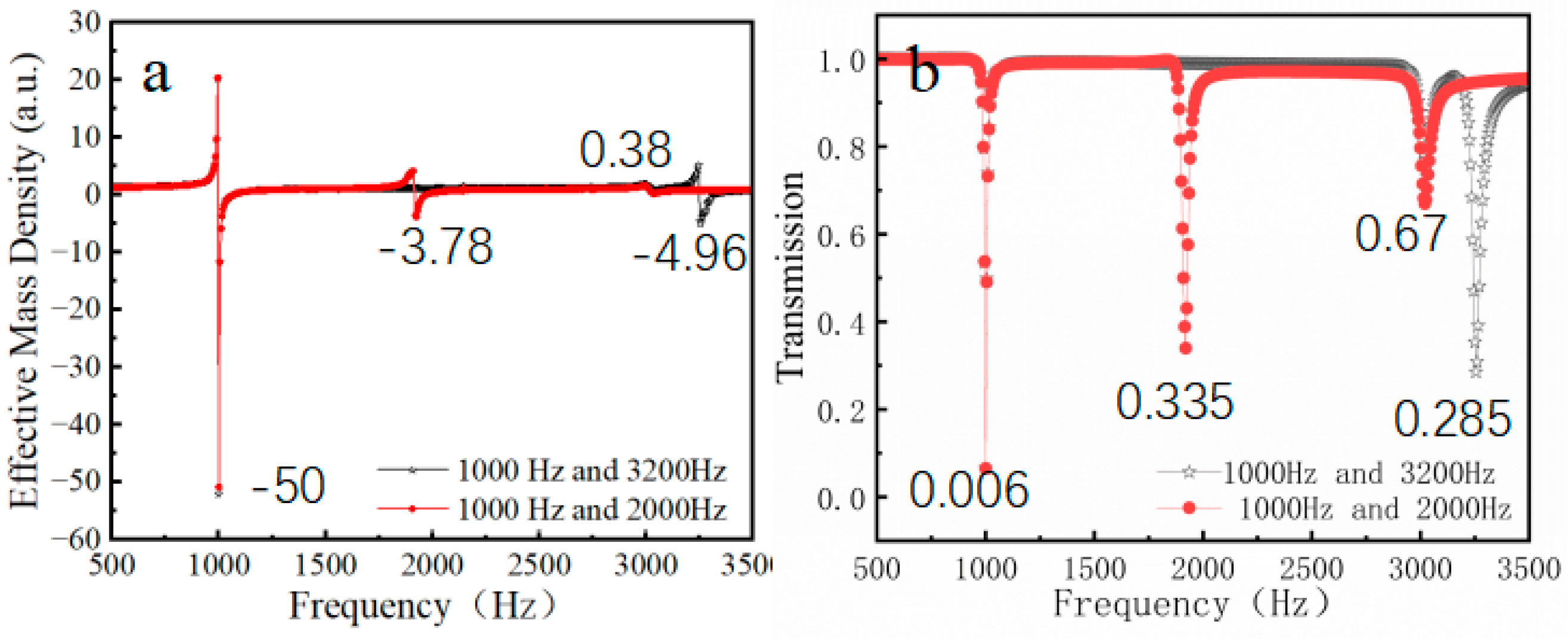
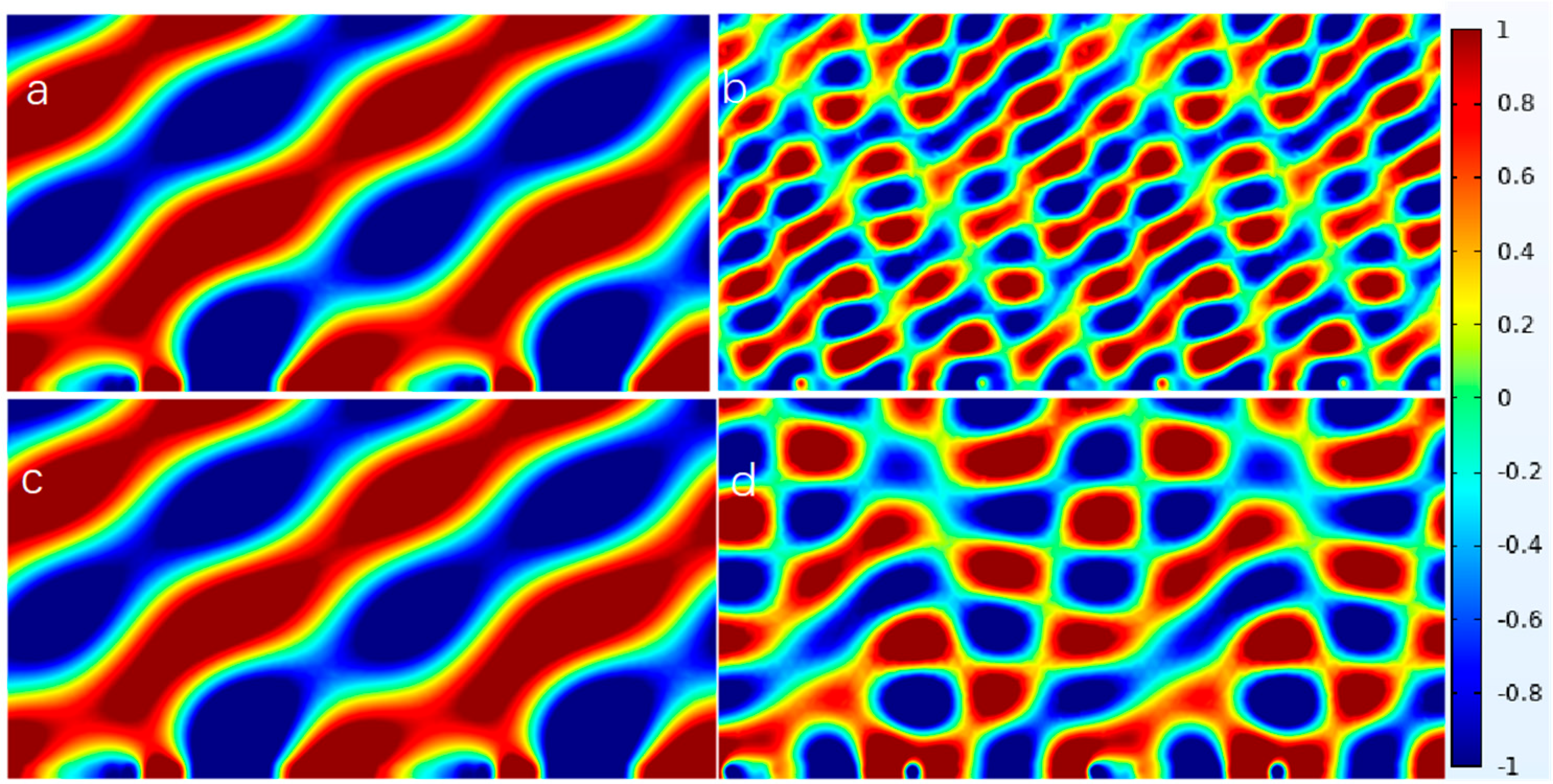
Disclaimer/Publisher’s Note: The statements, opinions and data contained in all publications are solely those of the individual author(s) and contributor(s) and not of MDPI and/or the editor(s). MDPI and/or the editor(s) disclaim responsibility for any injury to people or property resulting from any ideas, methods, instructions or products referred to in the content. |
© 2025 by the authors. Licensee MDPI, Basel, Switzerland. This article is an open access article distributed under the terms and conditions of the Creative Commons Attribution (CC BY) license (https://creativecommons.org/licenses/by/4.0/).
Share and Cite
Hao, L.; Liu, D.; Yan, X.; Yang, Q.; Guo, J.; Tian, X.; Xie, Y.; Pang, S.; Zhang, T.; Chen, Z. Dual-Band Resonant Acoustic Metasurfaces from Nested Negative Effective Parameter Unit. Materials 2025, 18, 2811. https://doi.org/10.3390/ma18122811
Hao L, Liu D, Yan X, Yang Q, Guo J, Tian X, Xie Y, Pang S, Zhang T, Chen Z. Dual-Band Resonant Acoustic Metasurfaces from Nested Negative Effective Parameter Unit. Materials. 2025; 18(12):2811. https://doi.org/10.3390/ma18122811
Chicago/Turabian StyleHao, Limei, Dongan Liu, Xiaole Yan, Qingning Yang, Jifeng Guo, Xingchen Tian, You Xie, Shaofang Pang, Tao Zhang, and Zhi Chen. 2025. "Dual-Band Resonant Acoustic Metasurfaces from Nested Negative Effective Parameter Unit" Materials 18, no. 12: 2811. https://doi.org/10.3390/ma18122811
APA StyleHao, L., Liu, D., Yan, X., Yang, Q., Guo, J., Tian, X., Xie, Y., Pang, S., Zhang, T., & Chen, Z. (2025). Dual-Band Resonant Acoustic Metasurfaces from Nested Negative Effective Parameter Unit. Materials, 18(12), 2811. https://doi.org/10.3390/ma18122811





